Properly sorting your waste has numerous benefits for the environment and your community. It aids in recycling efforts, reduces landfill use, and promotes a cleaner environment. For instance, efficient Baltimore County trash pickup services rely on residents properly sorting their waste to ensure recyclable materials are not sent to landfills. This segregation helps in recycling and the proper disposal of waste, preventing it from entering waterways and other natural habitats.
Sorting waste also has economic benefits. It can reduce the costs associated with waste processing and landfill maintenance. Additionally, recycling materials can generate revenue and support industries focused on sustainable production. According to the Institute of Scrap Recycling Industries (ISRI), the recycling industry generates billions of dollars in economic activity and supports tens of thousands of jobs in the United States. This economic contribution demonstrates that effective waste sorting benefits the environment and bolsters the economy.
Understanding the Different Categories of Waste
Recyclables
These include paper, cardboard, glass, metal, and certain plastics. Recycling these items helps conserve natural resources and reduce pollution. For example, recycling aluminum cans saves up to 95% of the energy required to make the same amount of aluminum from raw materials. The energy savings from recycling just one ton of aluminum equates to a home’s energy consumption over ten years.
Organic Waste
Organic waste covers food scraps, yard waste, and other biodegradable materials. These can be decomposed to make soil amendments that are high in nutrients. In addition to producing a valuable product for landscaping and agriculture, composting lowers the amount of garbage that is dumped in landfills. Organic waste is an effective tool for sustainable agriculture since it may greatly increase soil fertility, water retention, and microbial activity.
Hazardous Waste
Items such as batteries, paint, chemicals, and electronics fall into this category. They require special handling to prevent environmental contamination and should be disposed of at designated facilities. Hazardous waste should be disposed of properly to prevent soil and water pollution, which puts both people and wildlife at serious danger for health problems. For instance, poisons and heavy metals found in electronic trash can seep into the ground and water, harming the ecosystem over time.
General Waste
General waste includes items that cannot be recycled or composted. These materials often end up in landfills, making it crucial to minimize their volume as much as possible. Non-recyclable plastics, contaminated food packaging, and certain textiles usually fall in this category. Minimizing general waste can be achieved by making conscious consumer choices and opting for products with minimal packaging or reusable alternatives.
Step-by-Step Guide to Sorting Your Waste
Step 1: Identify Waste Categories
Start by identifying the different categories of waste generated in your household. Use separate bins for recyclables, organic, hazardous, and general waste. Clearly label each bin to avoid confusion and ensure all household members know where to dispose of different types of waste.
Step 2: Educate Yourself on Local Guidelines
Familiarize yourself with the waste disposal guidelines specific to your locality. Regulations vary, so knowing what can and cannot be recycled or composted in your area is essential. Local municipalities often provide detailed guides and resources online to help residents sort their waste correctly. Ignoring these guidelines can lead to improper disposal and contaminate entire batches of recyclable materials.
Step 3: Clean Recyclables
Ensure that recyclable items are clean and free from food residue. Contaminated recyclables can spoil the entire batch, rendering it non-recyclable. For example, a single greasy pizza box or food-coated plastic container can make an entire recycling load unusable. By rinsing out containers and ensuring they are dry, you can significantly improve the efficiency and success of recycling programs.
Step 4: Separate Organic Waste
Gather organic trash, such as leftover food and yard debris, in a special container. If you have a garden, you might choose to use a local composting service or create a compost pile. In addition to lowering the amount of waste produced in homes, composting kitchen scraps produces rich soil that can be utilized for indoor gardening and helps promote a circular waste system.
Step 5: Safely Dispose of Hazardous Waste
Hazardous garbage needs to be handled carefully. When disposing of goods like batteries, electronics, and chemicals, use the specified drop-off sites. Hazardous waste pickup activities are periodically offered by many towns. Hazardous items are kept out of landfills and off the soil and water by being securely stored and transported to these facilities.
Step 6: Reduce General Waste
Choose reusable products and make environmentally conscious purchasing decisions to minimize general waste. Properly dispose of non-recyclable items in the designated general waste bin. Opt for products with minimal packaging, use cloth bags instead of plastic, and buy in bulk to reduce overall waste.
Tips for Effective Waste Sorting
- Label Your Bins: Label each bin with its intended waste category to avoid confusion.
- Create a Sorting Station: Establish a dedicated area in your home for sorting waste, making it easy for everyone to follow the guidelines. A well-organized sorting station encourages household members to sort waste correctly and consistently.
- Stay Informed: Keep up-to-date with local recycling and waste management guidelines as they may change over time. Attend local community meetings and check local government websites for updates on waste sorting practices.
- Engage Your Household: Educate family members on proper waste sorting practices and ensure everyone participates. Make waste sorting a family activity and emphasize its importance for environmental sustainability.
- Use Resources: Take advantage of local resources such as recycling centers, composting programs, and hazardous waste disposal events. Utilize community services to handle waste more efficiently and responsibly.
Common Mistakes to Avoid
When sorting waste, avoid the following common mistakes to ensure effective disposal:
- Contaminating Recyclables: Ensure recyclables are clean and dry to avoid contamination. Dirty recyclables can compromise the entire recycling process. For example, food residue left on containers can attract pests and create hygiene issues, leading to the rejection of an entire batch of recyclable materials.
- Improper Disposal of Hazardous Waste: Batteries, electronics, and chemicals should never be disposed of in conventional garbage or recycling receptacles. They need to be handled carefully. The health and safety of people are at risk if these things are disposed of improperly because they can cause hazardous reactions, fires, or environmental contamination.
- Ignoring Local Guidelines: Different areas have different waste disposal rules. Ignoring local guidelines can lead to improper waste handling. Adhering to local regulations ensures that waste is processed correctly and supports the overall efficiency of waste management systems.
- Overlooking Organic Waste: Failing to separate organic waste means missing out on valuable composting opportunities to benefit the environment. Composting organic waste reduces methane emissions from landfills and produces nutrient-rich compost that enhances soil health.
Conclusion
Properly sorting your waste is a simple yet powerful way to contribute to environmental sustainability and ensure efficient waste management. Following the steps outlined in this guide and making small changes in your daily routine can significantly reduce your ecological footprint.
Sustainable waste management starts at home and extends to the larger community. By adopting proper waste sorting practices, using resources like recycling and composting programs, and staying educated about waste management, everyone can contribute to a cleaner, healthier planet. The combined efforts of individuals, households, and communities play a crucial role in achieving sustainability goals and preserving our environment for future generations.





